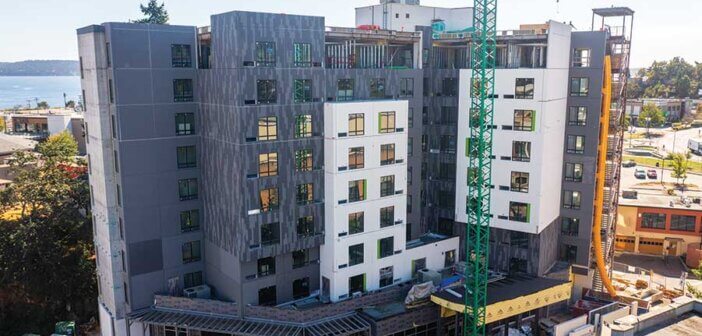Sustainable hospitality practices are critical. Without a doubt, hotels are ramping up their environmental, social and governance (ESG) initiatives, but what about practices that exist before a hotel opens its doors to guests?
Sustainably built hotels—near-zero construction waste, non-cement materials, etc.—are gaining attention. By partnering with sustainable buildings solutions companies like Nexii, hotels can reduce climate impact and on-site construction waste. Nexii’s technology can also accelerate construction times.
“Buildings and construction are the top sources of climate pollution and municipal waste,” said Zosia Brown, PhD, VP, sustainability, Nexii Building Solutions. “We need to ensure that all new construction is smart green construction to keep our planet healthy and livable.”
By combining clean manufacturing, flat-pack transportation and on-site assembly, Nexii’s construction waste is near zero, Brown said, and the company is continuing to invest in research and development to eliminate waste from its processes entirely.
“According to the Global Hotel Decarbonization Report, in order to avoid increasing carbon emissions due to the predicted growth of the hospitality industry, hotels need to reduce their carbon emissions per room per year by 66% by 2030 and by 90% by 2050,” Brown noted. “Current targets set by most hotel companies are below that level. And to limit warming by the 1.5° Celsius needed to avoid the very worst-case scenario, the industry has to go even further.”
So, how can Nexii help? Its airtight system means its buildings require less energy to heat and cool. It also creates healthy buildings without Volatile Organic Compounds (VOCs) or off-gassing and improved indoor air quality due to its airtight building system and uses Nexiite, a sustainable alternative to concrete that reduces end-to-end carbon emissions. All of Nexii’s products are 100% free from Red List materials (at levels greater than or equal to 100 ppm).
A prime example of its practices is the Courtyard by Marriott hotel in Nanaimo on Vancouver Island. Investor PEG Companies, which planned and developed the hotel, partnered with Nexii to construct the building’s exterior envelope.
The hotel’s envelope was made using non-toxic materials that have 25% less embodied carbon than conventional construction materials. Additionally, Nexii manufactured 750 unique structural panels, all made from Nexiite, for the nine-story hotel at its production facility in Squamish, British Columbia.
“Nexii’s building system requires fewer resources, produces far less waste and uses non-toxic materials for healthier living,” Brown said. “Our products are precision manufactured off-site and rapidly assembled on-site, reducing build times and construction costs. Our buildings are incredibly durable, adaptable to most designs and cost-efficient. They require a fraction of the materials and significantly less build time when compared to current construction methods.”
These materials are essential for the hospitality industry, as its growth is higher than that of other commercial buildings, Brown explained.
“Approximately two-thirds of the hotel supply is not part of a corporate chain, which makes progress tracking and joint efforts harder to achieve,” Brown said. “More than 90% of the hotels in the U.S. are franchised and their energy usage and greenhouse gas (GHG) emissions are usually not included in the corporate brand’s sustainability plans/tracking efforts.”
She continued, “In the recent decade, the definition of a hotel has evolved. The popularity in home-sharing sites has widened the industry without including their attributions to the carbon emissions in the hotel industry. Builders for corporate or franchise hotel owners need to bring alternative building solutions that are higher in carbon reduction to account for the entire hotel/accommodations industry to help offset those who are contributing to its emissions but have not been accounted for.”
For sustainable hotel construction, Brown recommends features such as an airtight envelope, which reduces operations’ carbon emissions, and lower-embodied carbon building materials, which encompasses the GHG emissions from extraction, manufacturing, transportation and assembly of building materials through to end-of-life.
Brown also recommends these practices for existing structures or renovations with companies looking to incorporate more sustainable practices.
“Integrating materials such as Nexii’s high performance panels that form an airtight, energy-efficient thermal envelope can further save on heating and cooling operating costs,” she said. “Renovating and retrofitting will dramatically reduce embodied carbon typically inherent in new-builds, and occupants will enjoy modern, healthy and beautiful environments.”


